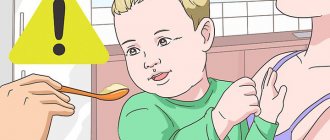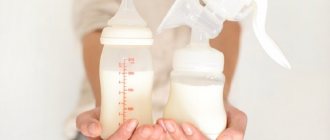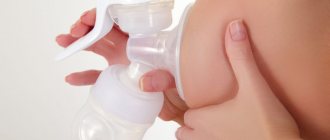Mother's milk is an ideal food for a child in the first year of life, which helps the baby develop properly and increases the body's defenses. Unless absolutely necessary, you should not give up breastfeeding, but for various reasons, breast milk production may noticeably decrease or disappear completely.
Restoration of lactation is possible even after a long break from breastfeeding. To achieve success, it is important to follow the rules and be patient if the process threatens to drag on.
It is important to understand that the percentage of “non-dairy” women, who naturally have an extremely low ability to lactation, is quite small, so it is worth fighting to feed the baby with your milk.

Reasons for decreased lactation
The decline of lactation occurs for various reasons, including those related to the health of the mother or child. First of all, it is necessary to understand what prompted the deterioration or cessation of milk production and, if possible, eliminate the causes of decreased lactation.
Restoration of lactation is required in the following cases:
- lactation crisis;
- a break in breastfeeding for medical or other reasons;
- improperly organized breastfeeding;
- loss of milk due to overwork or stress;
- low milk production due to the child’s poor appetite.

Nutrition for a nursing mother in the first month
A nursing woman must eat enough calories, but proper, healthy food. Starving yourself (to lose weight) or severely restricting yourself (due to the threat of allergies in the baby) is now not recommended.
You should definitely exclude, especially at the beginning: smoked foods, fried foods, too fatty and salty foods, pickled vegetables, red fruits, citrus fruits, alcohol.
Everything else is possible.
You need to drink about 2 liters per day, it is best to drink water, fruit drinks, compotes, tea with milk.
In this case, the principle is true: if there is fluid in the body, there will be milk.
Lactation crisis
Breast milk production may decrease markedly from time to time. The reason is hormonal changes in the mother’s body, including the restoration of the menstrual cycle, sudden growth spurts in the baby associated with an increase in the need for food.
The duration of the crisis does not exceed two to three days if it is monitored and milk production is additionally stimulated.
During a lactation crisis, do not be nervous and switch your baby to formula. It is enough to drink more warm water, massage your breasts and put your baby to it more often. Breast milk volumes are restored within three days, after which feeding can be continued as usual.

Break from breastfeeding
Stopping breastfeeding may be necessary for medical reasons, which include the recovery period after breast surgery, or taking medications that are unsafe for the child.
Breastfeeding is interrupted for some time and when mother and baby are separated. The cause is illness of the child or mother, or the mother’s high employment. The baby can receive expressed milk, but lactation decreases due to insufficient stimulation of the mammary glands, which requires further restoration of breastfeeding after a forced break.
Incorrect organization of natural feeding. Common breastfeeding mistakes that lead to the extinction of lactation include feeding the baby by the hour rather than on demand, lack of night feedings, supplementing with water, and using a pacifier.
Signs of low breast milk
Many young mothers tend to panic about insufficient lactation. Sometimes their fears are justified, but in other cases they are completely unfounded. How can you determine whether your baby really does not have enough milk or if it just seems to you? There are certain “symptoms” that can help you understand whether a child is eating enough.
See also:
The most effective herbs for stopping lactation Stopping lactation
Modern anti-lactation pillsCessation of lactation
What drugs exist to stop lactation? Termination of lactation
The first indicator that a young mother needs to pay attention to is the baby’s weight. Normal weight gain for a child under six months should be at least one hundred twenty-five grams per week. During this period, the baby gains weight more rapidly. After six months, weight gain should be at least three hundred and fifty grams per month, and after ten months - no less than two hundred and fifty grams. However, this indicator cannot be a sure sign of “malnutrition” - because it is often influenced by other circumstances, for example, a child’s illness or stressful situations.
The next symptom worth mentioning is the baby's insufficient urination. If your baby is less than six months old and is fed exclusively on breast milk, then he should pee at least twelve times a day. Older children and children on complementary foods do this less often. Observe your baby's urination and draw conclusions.
Another sign is the child’s behavior. If he is capricious during feeding, and after it he is restless, if he sucks at the breast for a long time and with effort, and less than an hour after “lunch” he wants to eat again, then this is worth paying attention to. It is necessary to monitor the baby's stool, which should not be liquid, thick or sparse, or have a strong odor. All these signs alone do not always mean that the baby is not getting enough breast milk, but if most of them appear, it’s time to take action.
How to restore lactation?
The decline or complete cessation of breast milk production is in most cases a solvable problem. Resuming natural feeding is easier the younger the child is. For a baby up to three months old, solving the problem takes 1-2 weeks; older children will have to work longer, but the result will come if you don’t give up.
A favorable psychological climate for a nursing mother and help with household chores are very important, since maximum time will be devoted to the baby. If you have any questions, it is recommended to contact a breastfeeding specialist, who is better to find in advance.
If milk has completely disappeared or is produced in insufficient quantities, the following actions should be taken:
- ensure constant physical contact with the child;
- avoid overwork and stress;
- stimulate baby's breastfeeding;
- gradually reduce supplementary feeding;
- monitor your own nutrition;
- use means to increase lactation (herbal remedies, massage, etc.).

What to do if milk is lost: how to resume lactation
If milk is lost, how to resume lactation? This question haunts women who breastfeed their children. For a newly born baby, the most important person is the mother. Thanks to her, the newborn receives warmth, care and food.
However, it happens that a mother’s breast milk disappears. When milk production decreases, the baby does not eat enough. But pediatricians do not recommend switching the baby to artificial feeding if problems with lactation arise, since breast milk contains elements that are very important for his health.
How to resume breastfeeding? What can I do to get my breast milk back? Before answering this question, it is necessary to determine the reasons for the loss of mother's milk.
Reasons for the disappearance of breast milk
There are many reasons why lactation may be disrupted.
The most common reasons for decreased milk production are:
- supplementing the baby with artificial formulas ahead of schedule;
- restless state of a nursing woman;
- using a bottle;
- mother's state of fatigue.
If you start feeding your baby earlier than 6 days after milk production stops, this can lead to its complete disappearance. A baby who receives food through a nipple realizes that it is easier to satisfy hunger this way than through the mother’s breast.
Usually, minor malnutrition for a child for about 2-3 days will not harm in any way. You need to make sure that weight gain is normal and the frequency of urination is up to 8 times per day.
If you need to introduce complementary foods for a certain time, feeding should only be done with a spoon.
Excitement in a nursing woman can also cause a lack of breast milk. Any depression and stress lead to a decrease in oxytocin content in the female body. This hormone is responsible for proper breastfeeding.
When feeding the baby with a bottle, the mammary glands of the nursing mother gradually lose the function of producing breast milk. This happens due to the fact that the baby is less likely to attach to the breast, and the mammary glands are not stimulated by sucking the baby.
Another reason why a mother may lose breast milk is systematic fatigue. Since after the birth of a child there is an excessive amount of troubles and worries, the young mother can become very tired.
Lack of rest can be a reason for the complete cessation of breast milk production. Therefore, you should not take on everything at once, because this is fraught with unpleasant consequences.
The help of relatives will be very helpful in this case.
Proper nutrition
It is important to remember: before using any products that increase breast milk production, you should consult with a specialist who will give the right recommendations.
It is possible to restore lactation by taking special lactogenic drinks. One such remedy is caraway tincture. The preparation method is as follows: brew 1 tsp in a glass of hot milk. cumin seeds. The infusion must be kept for 2 hours. Half an hour before feeding the baby, the mother should drink 1/2 cup of the product.
Walnuts with milk will help improve lactation. You need to take 12 nuts and finely chop them, then pour 0.5 liters of hot milk into the resulting mixture. The product should be infused for about 2 hours in a special thermos. The drink should be consumed 20 minutes before lactation, 0.5 cups.
In order for milk to begin to be produced again, experts recommend taking anise tincture. You will need to take 1-2 tsp per glass of boiling water. anise seeds Leave for about 1 hour. Use 1/4 cup of the finished drink.
For similar purposes, you can use a nettle decoction: 1 tbsp. l. dry leaves of the plant need to be filled with 1 tbsp. boiling water The decoction should be infused for 30 minutes in a closed container and then taken before meals.
During the lactation period, a woman does not necessarily need to eat much more food than usual. However, the diet should include foods that improve the quality and quantity of mother's milk.
Among them are hard cheeses, cottage cheese products, milk or kefir, as well as products with a high protein content (poultry, fish). The volume of fluid consumed during breastfeeding should be at least 2 liters per day.
Recommendations for resumption of lactation
Nursing mothers should take a contrast shower in the morning and in the evening. The stream of water must be directed towards the mammary glands, moving it clockwise. Then you should turn so that the water hits the area of the shoulder blades. This technique leads to stimulation of the mammary glands. After this, milk begins to arrive in large volumes.
Resuming breast milk production is possible by using a medicinal bath. You should pour warm water into the container, and then lower your chest into it.
After 15 minutes, dry your chest with a towel and dress warmly. It’s better to immediately lie down under the blanket, as you can’t chill your mammary glands. After a few minutes, you can put your baby to your breast.
As a rule, feeding after a therapeutic bath shows that the volume has increased significantly.
Experts recommend massaging the mammary glands for about 3-4 minutes, using light circular movements. You can use a small amount of castor oil for this. During the massage, the woman should completely relax without feeling any discomfort. During the massage, the mammary glands begin to actively produce breast milk.
Restoration of lactation is carried out through rest. For these purposes, it is recommended to take your baby for walks in the fresh air more often. All housework should be postponed until the future; you can entrust it to someone else. The more often a nursing woman rests, the better this affects lactation.
The production of breast milk is carried out due to the content of the hormone prolactin in the body. Its production is carried out due to the frequent attachment of the baby to the mother's breast. During feeding, the baby should be applied first to one breast and then to the other. At the end of feeding, the remaining milk must be expressed.
Body contact and psychological comfort
In order to restore lactation as quickly as possible, mother and baby need to be together around the clock. Constant skin-to-skin contact helps the mother's body produce prolactin and oxytocin, hormones that promote lactation.
The baby is in the most comfortable environment, awakening instincts - this is facilitated by the warmth of the mother’s body and the smell of milk. He develops better and begins to suck more actively.
For constant physical contact, the child should spend most of his time in his mother’s arms or in a sling. Sleeping together at night with the opportunity to sit comfortably for feedings is also important. In this case, the mother will not have to regularly get up to the child, experiencing additional stress.
Household chores will have to be transferred to the husband and relatives, since milk can only be returned by completely switching to the child. It is important to avoid overwork and stress to prevent the production of hormones that interfere with lactation.

Breastfeeding stress is not a hindrance: how to restore lactation after a nervous breakdown
“Burn out”, “disappeared” - this is how they often write about breast milk, which supposedly stopped being produced by a nursing mother as a result of nervous overstrain. Yes, indeed, this also happens: a strong fright, an illness, or just a difficult stressful day - and the chest suddenly becomes empty and soft, as if there was no breastfeeding at all. “The milk is burnt!” - grandmothers, doctors and the Internet shout in a friendly chorus, sending mom to the pharmacy for the mixture.
Therefore, here is some good news for you right away: even if you are nervous and it seems that the milk has disappeared forever, it can still be returned in the same volumes, and even more.
First, it’s worth remembering where milk in the breast comes from in the first place. Immediately after a new baby is born, the level of progesterone in the mother’s body drops sharply, and the level of prolactin, on the contrary, soars. And this prolactin begins to intensively produce milk for the new person. Meanwhile, in the hypothalamus (we have such a gland in our heads), the hormone oxytocin is actively produced, which after some time begins to remove this milk out through the milk ducts of the breast. Then we say that “the milk is coming.”
The hypothalamus, by the way, is a flight control center in the endocrine system: it receives signals from the centers that regulate the activity of the respiratory and cardiovascular systems, there are centers of hunger, thirst, sleep and wakefulness, regulators of our emotions and behavior. Oxytocin is also produced there on an ongoing basis, regulated by the pituitary gland (another gland in the head J) and released into the blood in large quantities when we give birth, breastfeed, experience orgasm, or even just mentally communicate with pleasant people.
So, until the hypothalamus disappears from the female body, milk, if there was any, cannot disappear completely. However, such a phenomenon as hypogalactia - decreased function of the mammary glands - is actually not so rare. A special case of hypogalactia is a sudden cessation or decrease in milk production in a nursing mother as a result of physical or mental stress, or, as they say now, “from stress.”
In such hypogalactia, when milk supposedly disappears from nerves, hormones are again to blame. The stress hormone adrenaline is an antagonist of oxytocin, which, as we remember, releases milk lovingly produced by prolactin. Therefore, if a nursing mother experiences severe pain, shock or fear, the production of oxytocin is blocked. Because in such cases, the body rightly decides that now is not the time to feed, it needs to be saved. And the outflow of milk decreases or stops.
How to perform relactation (restore milk flow)?
It would be logical to assume that when the level of adrenaline subsides, the level of oxytocin will naturally recover. So if such a nuisance suddenly occurs in your breastfeeding life, you need to remember that lactation, by and large, is nothing more than a dance of hormones. And if there are suddenly interruptions in oxytocin, you need to create favorable conditions for its production, and everything will be fine again.
What can increase oxytocin production:
- Non-stress. Situations are different, of course, and not every source of stress can be removed easily and quickly, but it is important to keep in mind that when the feeling of anxiety and fear in the head stops, the body will take this as a signal that you can return to everyday affairs - for example, breastfeeding .
- Positive emotions are the main enemy of adrenaline. Chocolate, a bubble bath, shopping or even cleaning (physical activity in general) - all this reduces the level of adrenaline in the blood and releases oxytocin. Well, let's not forget about sex


- Frequent latching of the baby to the breast. Everything is clear here: nipple stimulation by anyone (and to a large extent by a child) stimulates the production of oxytocin. Frequent, regular feeding helps to establish lactation even in nulliparous women with adopted children - not such a rare thing, by the way (see the story about the feeding of a child by an adoptive mother). This also includes tactile communication with the child in general - all kinds of tenderness, hugs and skin-to-skin contact. You can use the “kangaroo method” (see article Kangaroo Care).
- Expressing the free breast while feeding the baby (by hand or with a breast pump) to “accelerate” lactation again.
In general, a set of methods called “nesting” mainly helps to restore lactation - in fact, this is what women who have given birth do in traditional societies.
Namely: they lay down together with the newborn in a den made of blankets and pillows and closely engage in breastfeeding. Are isolated from household chores and any sources of stress. They put the baby to the chest according to every squeak and call of the heart. They eat delicious food, drink warm tea, and generally relax in every possible way. It is clear that in today’s fast-paced world, not every mother can afford such a resort, but you can still try to imitate it. Here are two examples of successful relactation, when milk stopped being produced for various reasons, but after some efforts by the nursing mother, breastfeeding was completely restored:
Larisa, Dani's mother, 14 months (relactation at 6 months, breastfeeding continues):
“When I was feeding my second child (I nursed the first for 2 years and 10 months), during his six months, a misfortune happened in my family - a loved one ended up in intensive care. I had to leave the baby to go to the hospital. Unfortunately, they are not allowed into the adult intensive care unit with a baby, and I stopped taking him with me so that someone could sit with him in the hall after a week of such adventures when he developed green snot and fever. We just started introducing complementary foods, so we had to pump. I never had any problems with milk - the children gained 2 kg in the first month, were always plump, and did not give the impression of being malnourished at all, so when I sat with a good electric breast pump for 25 minutes for the first time and pumped only 15 ml of milk - I was very I was surprised. I went looking for information - how to increase the amount of pumping, I intuitively guessed to express one breast when I feed the other - and voila, within 2 minutes of starting feeding I had a full bottle: 180 ml! This is how I felt the effect of stress on myself, and if I had not been actively breastfeeding for a long time, I probably would have decided that the milk had disappeared due to stress. It didn’t disappear anywhere - it was just difficult to separate due to adrenaline, which was proven by pumping during breastfeeding.”
Inna, mother of Vladik 2 years 11 months. (relactation at 2 years of age, breastfeeding continues):
“When my child was 2 years old, I decided to fulfill my civic duty and go as an election observer.

An important point: while mother and baby jointly restore breastfeeding and get rid of harmful stress, in the absence of milk the child must somehow eat. If the baby is clearly hungry and you cannot do without supplementary feeding with formula, you should avoid feeding from a bottle if possible - after a comfortable and easy-to-use nipple, the baby may refuse to extract milk from the breast. You can use a regular spoon or look at supplementary feeding systems (SNS).
Author of the article: Ekaterina Tsyvyleva
Stimulation of breast milk production
The main assistant in restoring lactation is the baby himself, since he is the one who regulates milk production. The more actively the baby suckles, the more intensely the hormone prolactin is produced.
If your baby is offered the breast frequently, he will eventually learn to suckle. It is necessary to put the baby to the breast without waiting for his desire; it is important that the baby satisfies not only hunger, but also the sucking reflex.
To restore lactation, you must stop using pacifiers and bottles with nipples for supplementary feeding. Sucking soft rubber does not require effort from the baby, and babies often make a choice not in favor of the mother's breast, from which it is much more difficult to obtain food.
If you do not use a pacifier to supplement formula or expressed breast milk, the baby will quickly learn to extract milk from the mother's breast. It is recommended to supplement the baby's feeding using a soft spoon or a special supplementary feeding system (more about it below).
If little milk is produced, but even then the baby does not completely empty the breast, it is necessary to express regularly - at least 8 times a day. Manual expression is not always effective, especially without the proper skill, so it is recommended to purchase a breast pump.
It is important to monitor the condition of the nipples - if cracks occur, you will have to take a break during the process of restoring natural feeding.

Reducing supplementary feeding
When restoring lactation after milk has disappeared, you should not suddenly give up the formula that the child was fed during the break in breastfeeding. Supplementary feeding is removed gradually, according to the “breast - supplementary feeding - breast” scheme: each feeding should begin and end with attachment to the breast.
The supplementary feeding device is a container with a soft thin tube, the end of which is attached to the breast - the baby grabs it along with the mother's nipple, getting used to sucking the breast. The container itself with the mixture is hung on a cord around the mother’s neck.
If supplementary feeding is sharply reduced, the child will develop a deficiency of substances that promote growth and proper development. At the same time, the baby must steadily increase the consumption of breast milk, not only fore milk, rich in lactose, vitamins and microelements, but also hind milk, containing fats and lactase.












